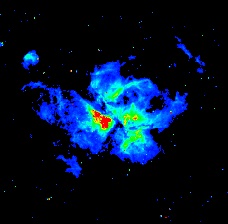Stars which are initially more than thirty times the mass of the sun
are extremely hot and luminous, such that they would outshine it by
a factor of 100,000. Their radiation field are extremely intense,
and drive off their outer atmosphere by photon pressure, producing
dense, high velocity stellar winds. Consequently, massive stars play
a dominant role in the ecology of their parent galaxies,
and in particular starburst galaxies, since (i) they are the
principal source of ionizing flux for the surrounding interstellar medium
(ISM); (ii) Their powerful stellar winds inject huge amounts of
mechanical energy into the ISM; (iii) they enrich their environments by
ejecting heavy elements via their winds and eventually through supernovae
explosions.

 The Carina nebula (shown right), at a distance of 8,500
light years contains dozens of hot, massive stars, including eta Car
(shown left) a giant star that underwent a huge eruption in the 19th
century, ejecting several solar masses of material over a decade as
revealed by Hubble Space Telescope images.
The Carina nebula (shown right), at a distance of 8,500
light years contains dozens of hot, massive stars, including eta Car
(shown left) a giant star that underwent a huge eruption in the 19th
century, ejecting several solar masses of material over a decade as
revealed by Hubble Space Telescope images.

 The Carina nebula (shown right), at a distance of 8,500
light years contains dozens of hot, massive stars, including eta Car
(shown left) a giant star that underwent a huge eruption in the 19th
century, ejecting several solar masses of material over a decade as
revealed by Hubble Space Telescope images.
The Carina nebula (shown right), at a distance of 8,500
light years contains dozens of hot, massive stars, including eta Car
(shown left) a giant star that underwent a huge eruption in the 19th
century, ejecting several solar masses of material over a decade as
revealed by Hubble Space Telescope images.